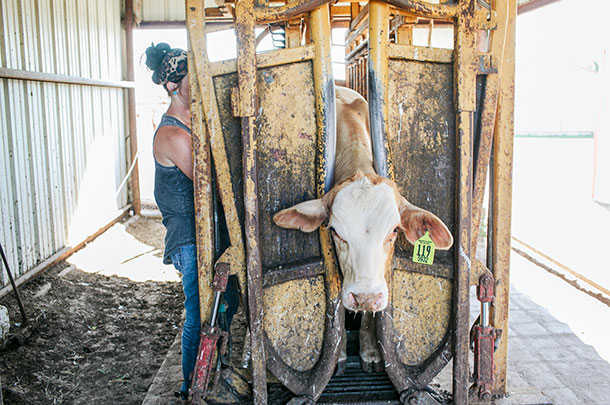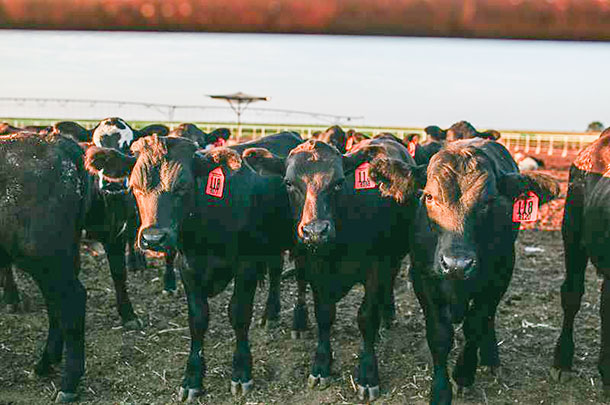Cimarron River is run by Rodney Derstein and his wife, Sadie. Their specialty is providing a smooth transition from ranch to feedlot while providing the best chance for lighter and smaller claves to grow up to a competitive feeder weight.
“People send their lighter, usually high-risk calves to us, kind of like sending your child to daycare,” says Rodney Derstein. “We do all the vaccinations and mainly get them started and get them healthy so they can go on to the next stage, whether that be grass or straight to the feedyard, or even out to wheat. It’s just a short phase to bring in cattle and get them straightened out so that they know what a feedbunk is and what a feed truck is and get them healthy.”
Derstein says they usually have about 1,500 head on the lot at a time, as well as any pasture cattle they take on during the winter months. Their specialty of bringing lighter calves up to a better feeder weight before shipping them off to a feedyard gives them an opportunity to operate in a niche market. “We’re out here in western Kansas where there’s a lot of feedyards,” Derstein says, “and we saw the opportunity to be out here in a drier climate with these feedyards – all of their customers are able to buy lighter calves and maybe make them work a little bit better than trying to buy a feeder to take straight to the feedyard.”

Derstein says he and his wife try to provide quality care and feed to their calves, which is sometimes a step up from a producer readying calves from the market on their own. “We have a consulting vet and a consulting nutritionist, and we try to provide the best quality care and atmosphere for those cattle, so I guess we try and be the best there is out there and try and do as good a job as if the cattle were our own,” Derstein says. “We try to use the best vaccines and the best feed out there – where in a traditional setting, they might not have that available to them.”
The Dersteins try to give their calves the best start possible as soon as they get off the truck. When calves arrive, they are greeted by a clean pen, fresh water and long-stem hay in the feedbunk. “We feed twice a day, first thing in the morning, then again at about noontime,” says Derstein. “Depending on how far those animals come, we typically let them rest for however long they’re on the truck, and then we will process those cattle.”
The Dersteins vaccinate and re-tag the calves, dehorn or cut calves if necessary, then test every calf for persistent infections. “We like to PI test everything because we can likely terminate sickness if we do that.”
Derstein says each group that comes in gets its own personalized feed program. “We rely on where those animals are from. Any information that we have on them is definitely helpful,” says Derstein. “We treat every set of animals individually. We pick different protocols for each set that comes in.”

Derstein says that it’s hard to put an actual value on backgrounding a calf rather than taking it to a feedyard because there are so many variables that come into play. He says factors like the origin of the cow, starting size and weight, and how healthy the calf is affect how it will perform. “It’s hard to put an actual number on it, just because there is a lot more work required compared to the average feedyard because it takes a lot more time. You want to look at those calves more often just because you want to be able to catch anything that’s not feeling good earlier so that your vaccines have a better chance of working for that calf.”
Derstein says that running the feedlot since he and his wife bought it in 2014 has been an interesting learning experience. The market has been tough the past few years, which has cut into their business. “Nobody’s really wanting to buy a calf if you can’t really pencil it to make any money,” Derstein says. “It’s difficult, but hopefully the market finds some stability soon.”
Derstein says that breaking into the industry has also been tough, but he is not discouraged. “It’s a small industry and definitely a reputation-driven industry, so I feel like the longer we’re in it, the more people will hear about us,” he says. “I’m sure there’s others out there who have things figured out, and we always just strive to do the best we can, and I guess that’s about all anybody can ask for.” ![]()

-
Carrie Veselka
- Staff Writer
- Progressive Cattleman
- Email Carrie Veselka
PHOTO 1: Rodney and Sadie Derstein work together to make sure each group of calves gets the best care.
PHOTO 2: The Dersteins also handle vaccinations and other “finish work” before sending the calves along to the next stage.
PHOTO 3: The Dersteins put together a customized feed and care program for each new group of calves they receive. Photos by Alyssa Henry.








